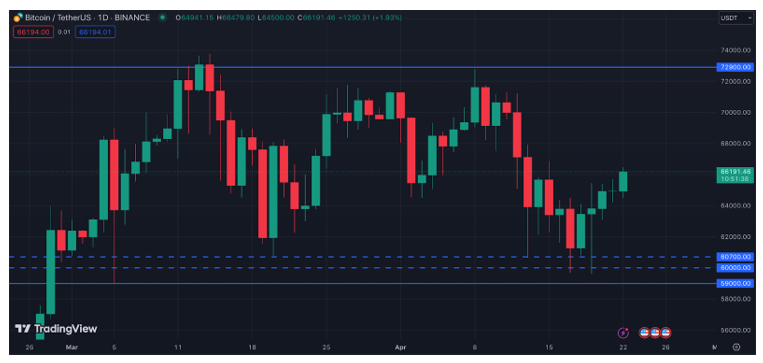 |
| By Marija Matic |
Bitcoin (BTC, “A”) miners faced a nervous wait for the recent halving, an event programmed into Bitcoin's code that cuts miner rewards in half every four years. That means miners have to validate twice as many blocks of transactions to earn the same reward.
But a rise in transaction fees, sparked by the launch of a new protocol called Runes, has created a surprising windfall for miners, at least in the immediate aftermath of the halving.
On April 20, miners raked in over $100 million in rewards, despite the halving! A record $80 million came from transaction fees alone.
These kinds of spikes undermine expectations of a post-halving slump for miners.
But to see if this trend has staying power, we need to go back to the basics and review how mining works.
Understanding Miner Rewards
Bitcoin miners play a pivotal role in fortifying the Bitcoin network. They engage in competitive puzzle-solving, with the victor receiving freshly minted BTC alongside transaction fees within each block.
This reward structure incentivizes miners to commit substantial computing power to the network.
However, the block reward diminishes over time, with the halving acting as a mechanism to curb BTC inflation. While this benefits long-term Bitcoin holders by constraining new supply, it can squeeze miner profitability.
The recent surge in transaction fees showcases how heightened network utilization could offset the halving's impact on miner revenue. Protocols like Runes — a new token standard, or set of rules, on the Bitcoin blockchain — may fuel profitability growth.
How? By streamlining token creation and trading directly on the Bitcoin blockchain. Although token creation on the Bitcoin network was feasible with the old standard, called BRC-20, since February 2023, Runes is simpler to use and offers enhanced security.
This isn’t the first time we’ve seen bolstered transaction fees and miner profitability. The advent of NFTs on Bitcoin via the Ordinals Protocol over a year ago had a similar effect. These innovative applications underscore Bitcoin's expanding functionality and potential to attract new users or increase activity among existing ones, potentially paving the way for sustainable miner income despite the halving mechanism.
While the long-term impact of these trends on miner profitability remains uncertain, the short-term surge in transaction fees post-halving provides some respite.
I should note, however, that not everyone in the community is so supportive. The rise of NFTs on Bitcoin a year ago sparked debates, with some developers and users deeming it "spam," leading to discussions of a potential hard fork, or a splitting of the Bitcoin network.
Especially since the benefit to miners comes at the expense of the user in the form of higher transaction fees.
Bitcoin maximalists — those who believe Bitcoin is the ultimate digital currency — present the strongest opposition to standards that make creating new assets on the Bitcoin blockchain easier. They view anything built on top of Bitcoin — including standards like Runes — as unnecessary spam and a misuse of limited block space.
Their ideal Bitcoin network remains pure, unclogged and dedicated solely to traditional transactions and savings.
This debate is leading to the emergence of three distinct camps of thought:
- Camp 1: Prioritize Core Functionality. This is one of the camps of the Bitcoin maximalists. It prioritizes code changes that will limit functionalities like NFTs and tokenization, which are seen as "spam" by hardliners. They aim to minimize clutter and maintain the network's focus on core functionalities.
- Camp 2: Maintain the Status Quo. This camp opposes any code alterations, regardless of their stance on NFTs or transaction fees. They advocate for the immutability of the code, even amid the impact of trading memecoins on the Bitcoin network.
- Camp 3: Evolve the Bitcoin Network to Reach Ethereum-Like Functionality. This camp advocates for code changes to make Bitcoin more like Ethereum, facilitating easier app development on the Bitcoin network.
Bitcoin’s Price After Halving
As debates around using the Bitcoin network for meme token creation continue, the post-halving period is anticipated to raise the estimated average production cost of one Bitcoin to approximately $53,000.
Naturally, this production cost differential will vary significantly globally based on how expensive electricity is locally. Less efficient mining operations are expected to transition to supporting the AI sector instead of Bitcoin, mirroring trends seen after previous halvings.
In the meantime, the current price of BTC remains profitable for the average miner, with the price rebounding above $66,000 after testing the $60,000 support level before the halving:

The total crypto market cap has also risen 4.5%, from $2.43 trillion to $2.54 trillion since last Monday, according to CoinGecko data.
Notable News, Notes & Xeets
- Swiss Bitcoin advocates launch a campaign to include BTC in National Bank reserves.
- Thailand will block unauthorized crypto platforms to combat online crime.
- Mt. Gox creditors receive an optimistic signal as repayment data gets updated, with fiat payments already arriving and crypto repayments expected soon.
What’s Next
With the halving behind us, the crypto space is buzzing about Grayscale's proposed Bitcoin Mini Trust spin-off fund. It would boast an industry-low fee of 0.15%, a significant drop from Grayscale's current 1.5% fee (the highest cost in the market).
The cherry on top? This spin-off is considered a non-taxable event for existing GBTC holders, unlike switching to a competitor's products, which could trigger a taxable event.
This not only benefits those considering switching to other funds due to GBTC's fees. It could also significantly reduce overall selling pressure within the Grayscale ecosystem.
That would be a positive development for the entire Bitcoin market … and, by extension, the entire crypto space.
After all, when Bitcoin goes up in a bull cycle, the broad market isn’t far behind.
While things may seem to settle in the aftermath of the halving, there is still plenty bubbling under the surface. Remember to keep up with our Weiss Crypto Daily newsletters to stay current on each new development.
Best,
Marija Matić



